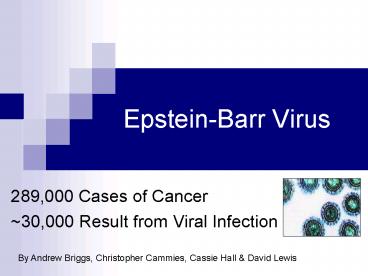EpsteinBarr Virus - PowerPoint PPT Presentation
1 / 11
Title:
EpsteinBarr Virus
Description:
By Andrew Briggs, Christopher Cammies, Cassie Hall & David Lewis. The ... T-cell responses by a chimeric antigen construct: potential therapeutic vaccine ... – PowerPoint PPT presentation
Number of Views:185
Avg rating:3.0/5.0
Title: EpsteinBarr Virus
1
Epstein-Barr Virus
- 289,000 Cases of Cancer
- 30,000 Result from Viral Infection
By Andrew Briggs, Christopher Cammies, Cassie
Hall David Lewis
2
The Epstein-Barr Virus (EBV)
- The virus is a member of the herpes family
- 95 of people contain antibodies against the
virus - Infection is controlled by T Cell Response
3
Tumours caused by EBV
Infection by EBV
Infection of B Cells
Infection of Epithelium
Malaria / c-myc translocation
Suppressed Immune System
Genetic Changes
Failure of virus to replicate
Post-transplant lymphoma
Burkitt lymphoma
Hodgkins lymphoma
Nasopharyngeal carcinoma
4
The Therapeutic Vaccine
- Immunotherapy is interested in targeting virus
associated tumours with cytotoxic T cells,
specific for viral antigens. - Since 95 of the population contain antibodies to
EBV, a traditional vaccine would have little
effect. - Previous studies have designed therapeutic
vaccines for EBV associated tumours containing
the common EBNA3 antigens. - Nasopharyngeal carcinoma doesnt contain this
antigen. - A therapeutic vaccine has been proposed by GS
Taylor et al for EBV associated carcinomas not
containing EBNA3 antigens.
5
Fusion protein MVA-EL
- Nasopharyngeal carcinoma
- cells contain the nuclear antigens
- EBNA1, LMP1 and LMP2. Not EBNA3
- which is common in other EBV
- associated tumours.
- LMP2 is a source for eliciting
- a CD8 response.
- EBNA1 is immunodominant over
- LMP1 and LMP2 as a target for CD4
- T cell response.
6
Can epitope specific CD8 T cells be reactivated
by exposure to MVA-EL infected stimulators?
- Results show an efficient expansion of FLY/A2 and
LLW/A2 specific memory cells following MVA-EL
infection.This is higher than LCL - Dendritic cells stimulated with MVA-EL expanded
the CD8 T cells specific for SSC/A11 (results
not shown).
YES
- ELISPOT assay- results are the number of
epitope-specific spot forming cells per million
cells in the culture - Were recorded on days 11 and 17 post-stimulation
- PBMCs came from EBV immune donors of relevant HLA
class I type these were then co-cultured with
MVA-EL or LCL
7
Can MVA-EL EBNA1 specific epitopes produce a
CD4 T cell expansion?
- Parallel series of experiments comparing the
ability of MVA-EL infected dendritic cells and
LCL to expand EBNA1 epitope specific CD4 T
memory cells. - Results show a significant difference between the
ability of autologous LCL and dendritic cells
infected with MVA-EL
8
Further testing of CD4 T-cells
- Results indicated that the PQC c1 was antigen
specific. - It can be assumed that EVA-EL is able to
directly access the HLA class II presentation
pathway due - to comparisons with LAMP-E1?GA results.
- Results confirmed that it is the endogenous EL
protein that is processed for the HLA class II
pathway. As the EL fusion protein was inactivated
after UV exposure.
9
Future Experiments
- This study is in vitro so we propose the
following in vivo Study required. - Misako Yajima generated a mouse model
(NOD/Shi-Scid IL-2Rynull with injected human
Haematopoietic stem cells) capable of
reconstituting human immune response to
Epstein-Barr virus in mice. - Vaccination of EBV-infected mice with MVA-EL,
with a control of mice infected without
vaccination. - Effectiveness of the vaccine to be screened over
3 month period. Screening via assays of virus
numbers, carcinoma cells present and symptoms.
10
Future Experiments cont.
- EBV expresses different latent proteins
(including EBNA 1,2, 3a,3b,3c and LP). Repeats of
this experiment using the different variants of
EBV, could potentially produce therapeutic
vaccines. - Generate an in vitro response to a different
array of virus, primarily expanding to other
virus inducing carcinomas, such as human
papillomavirus (HPV).
11
References
- Taylor, G. S., Haigh, T. A., Gudgeon, N. H. et
al. (2004) Dual stimulation of Epstein-Barr virus
(EBV)-specific CD4 - and CD8 - T-cell responses
by a chimeric antigen construct potential
therapeutic vaccine for EBV-postive
nasopharyngeal carcinoma. Journal of Virology
78(2) 768-778 - Rochford, R., Cannon, M. and Moormann, A. (2005)
Endemic Burkitt's lymphoma a polymicrobial
disease? Nature Reviews Microbiology 3 182-187 - Yajima, M., Imadone, K., Nakagawa, A. et al.
(2008) A new humanized mouse model of
Epstein-barr virus infection that reproduces
persistent infection, lymphoproliferative
disorder and cell mediated and humoral immune
responses. Journal of infectious disease society
of america 673-682































